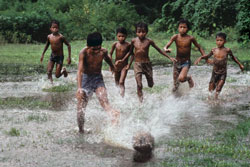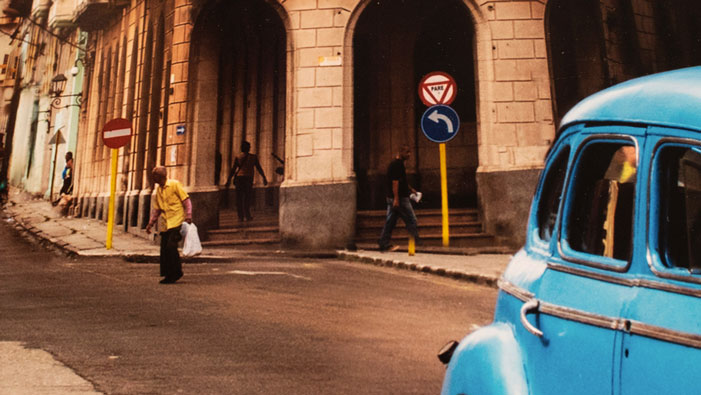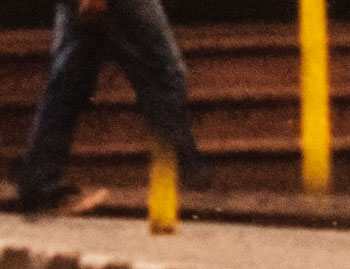Everything we see, feel and experience is an interpretation of “reality,” or “facts” if you want. Our cognitive senses are like filters. Nothing is perceived as is. Not two people on the planet see the exactly same things. Goes for reporting. Not two news reports report the same things, even though they report on the same “story.” Add the distortive factors distance and time, and facts can easily become fiction. Masterpiece film Rashomon for instance by Akira Kurosawa is a perfect example of this. An incident happened, yet every character involved witnessed a completely different story, providing alternative, self-serving and contradictory versions of the same incident. You thought you knew what happened. In the end nothing is clear any longer. So when photojournalism pretends to report facts authentically, without any alterations, interpretations or assumptions, is this even possible? And if photojournalism tweaks the image to make it look better and more captivating, is that a crime? Can it be a crime to interpret the interpretation of something? That’s the trap photographer icon Steve McCurry finds himself in. He’s accused of altering photographs to make them look better. I say, what ignorant minds still believe in the idea of the absolute?
It’s quite a thing to accuse the National Geographic and Magnum Photos legend Steve McCurry of altering images. And he did so, or at least his studio, as he claims. He would never have authorized such a change, reports PetaPixel, and the lab technician who made the mistake does not work with him anymore:


Naturally, this begs the question: where is the line between truth and manufactured reality in photography. Well, if the alteration doesn’t change the content of an image, or doesn’t lead to a different interpretation of the image or different conclusions, why should this even be a problem. Photoshop is a reality, and even the in-camera digital processing of an image is an alteration of the “original” incident already. So when does the manipulation of an image go to far?
Let’s get real. Doesn’t even the choice of photography equipment “manipulate” each and every shot? What camera, what lens? What’s excluded in the framing, what’s included, etc.? Still believe to be able to capture “facts” and “the truth”?
Says the Associated Press about its news values and principles, they never alter photo content:
AP pictures must always tell the truth. We do not alter or digitally manipulate the content of a photograph in any way.
The content of a photograph must not be altered in Photoshop or by any other means. No element should be digitally added to or subtracted from any photograph. The faces or identities of individuals must not be obscured by Photoshop or any other editing tool. Only retouching or the use of the cloning tool to eliminate dust on camera sensors and scratches on scanned negatives or scanned prints are acceptable.
Minor adjustments in Photoshop are acceptable. These include cropping, dodging and burning, conversion into grayscale, and normal toning and color adjustments that should be limited to those minimally necessary for clear and accurate reproduction (analogous to the burning and dodging previously used in darkroom processing of images) and that restore the authentic nature of the photograph. Changes in density, contrast, color and saturation levels that substantially alter the original scene are not acceptable. Backgrounds should not be digitally blurred or eliminated by burning down or by aggressive toning. The removal of “red eye” from photographs is not permissible.
Clear enough, isn’t it. Don’t add or subtract anything from a photograph. So McCurry did commit a crime?
Every photographer is always an artist. Every photographer should claim the right of artistic freedom, such as framing, exposure, etc. This freedom, it goes without saying, is strictly limited in the case of news reporting. But McCurry shooting some scene with kids playing, does an image manipulation constitute a breach of rules and trust?
Nonsense. But this doesn’t make the problem go away. Even if his studio altered it without him knowing, this begs the question what the people he employs are doing with his work he’s not approving of. But if McCurry was not working in a photojournalistic capacity, is he obligated by some imperative, moral or otherwise, to follow photojournalism standards simply by virtue of his reputation?
Again, nonsense.
It’s certainly a sign of weakness that he’s not able to provide a shot that exactly shows what he wanted to shoot. This would lead to the problem, would it be ethical to ask the boys to run through the water again, for a second and third shot, but this time more choreographically aware? No one would ever ask any questions later on, because no one would know that McCurry had asked the boys to stage the action.
What you don’t know won’t hurt you, isn’t it. Doesn’t make it right though?
This whole Steve McCurry controversy shows how limited our ability is to deal with the freedoms and possibilities we’re given by modern technology.
Who still believes in what one sees these days?
Who still believes in the idea of the absolute?
No one is lying here, no one is changing facts, no one is trying to tell a different story. I trust the name McCurry to authentically represent what he aims to represent. That’s right, the whole controversy boils down to a question of trust. And I’m actually glad the image looks better now. More balanced, more composed. Still not a great image. Should have purged it. Not worth the controversy which was kicked off by Italian photographer Paolo Viglione who visited McCurry’s current exhibition The World of Steve McCurry in Turin.
He noticed there was evidence of a poor Photoshop job in one of McCurry’s images:


If McCurry wanted to manipulate the images, why would he have approved such incredibly shoddy work? Even though, the content wasn’t meaningfully altered, and we shouldn’t mistake something factual for something truthful, and vice versa. And we should always question which facts and truths are employed, and how. There are not two people with the same truths.
Fellow Magnum Photos photographer Peter van Agtmael says in photography facts aren’t always truths:
The very nature of what is photographed and how is heavily affected by the influence of admired photographers with distinct personal visions, patterns of success in contests and the traditions and expectations of the commissioning body. Style, lens choice, position, what to show and what to exclude in the framing, editing, equipment choice, toning, sequence are all manipulative and subjective.
The result is a collection of facts that tends to be sanctimoniously declared as representing ‘truth.’ At best, these facts are a coherent personal truth. At worst, they are a distorted and overly dramatized look at complex issues in often marginalized, objectified communities. Often, they are something in between.
To capture something happening in a pinprick of time is inherently a limited means of understanding.
Steve McCurry tells stories. He’s a storyteller. That requires certain levels of interpretation. Stop the bigotry that it’s software that makes his work. If it’s more pleasing to the eye to enhance the message without altering it, Photoshop is a legit tool.


